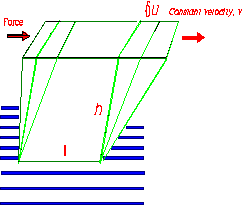Shear Strain:-
- To define the term STRAIN we will consider a cube of material with its base fixed to a surface as shown below in figure-1.
- If we now apply a constant 'pushing' force, F, to the upper part of the cube, assuming the material behaves as an ideal solid, it will obey Hooke's law of elastic deformation and will deform to a new position as shown in figure-1.
- This type of deformation (lower fixed upper moving) is defined as a SHEAR DEFORMATION.
- The deformation δ u and h are used to define the SHEAR STRAIN as :

- The shear strain is simply a ratio of two lengths (displacement / gap) and so has no units. It is important since it enables us to quote pre-defined deformations without having to specify sizes of sample etc
- The SHEAR STRESS is defined as F/A (A is the area of the upper surface of the cube l x w) Since the units of force are Newtons and the units of area are m^2 it follows that the units of Shear Stress are N/M2 This is referred to as the PASCAL (i.e. 1 N/m^2 = 1 Pascal) and is denoted by the symbol σ (in older textbooks you may see it denoted as τ)
Shear Rate:-
- Consider the case of a cube of material that behaves as an ideal fluid. When we apply a shear stress (force) the material will continually deform at a constant rate as illustrated in figure-2.
- The rate of change of strain is referred to as the SHEAR STRAIN RATE often abbreviated to SHEAR RATE and is found by the rate of change of strain as a function of time i.e. the differential d.
Viscosity
- The Shear Rate obtained from an applied Shear Stress will be dependant upon the materials resistance to flow i.e. its VISCOSITY
- Since the flow resistance ≡ force / displacement it follows that ;
VISCOSITY = SHEAR STRESS / SHEAR RATE
- The units of viscosity are Nm^2s Which are better known as Pascal Seconds (Pa.s)
- If a material has a viscosity which is independent of shear stress then it is referred to as an ideal or NEWTONIAN fluid. The mechanical analogue of a Newtonian fluid is a viscous dashpot which moves at a constant rate when a load is applied as seen in figure-3.

Viscosity
The resistance of a fluid to flow
1 Ns/m^2 = 1 Pa.s = 10 PoiseViscosity in Poise / Density = Kinematic viscosity in Stokes
Shear Stress
1 Pa = 1 N/m^2 = 10 dyn cm^-2Kinematic Viscosity
The dynamic viscosity divided by density
Shear Rate
The rate of change of shear stress. The velocity gradient perpendicular to the direction of shear flow (dv/dx). Units 1/s or s-1
Shear Stress
The shear force per unit area
Shear Strain
A unit-less quantity, the relative displacement of the faces of a sheared body (for example a layer of fluid) divided by the distance between them.
Zero-shear Viscosity
The viscosity at the limit of low shear rate. The viscosity a product will ultimately attain when at rest and undisturbed.



No comments:
Post a Comment